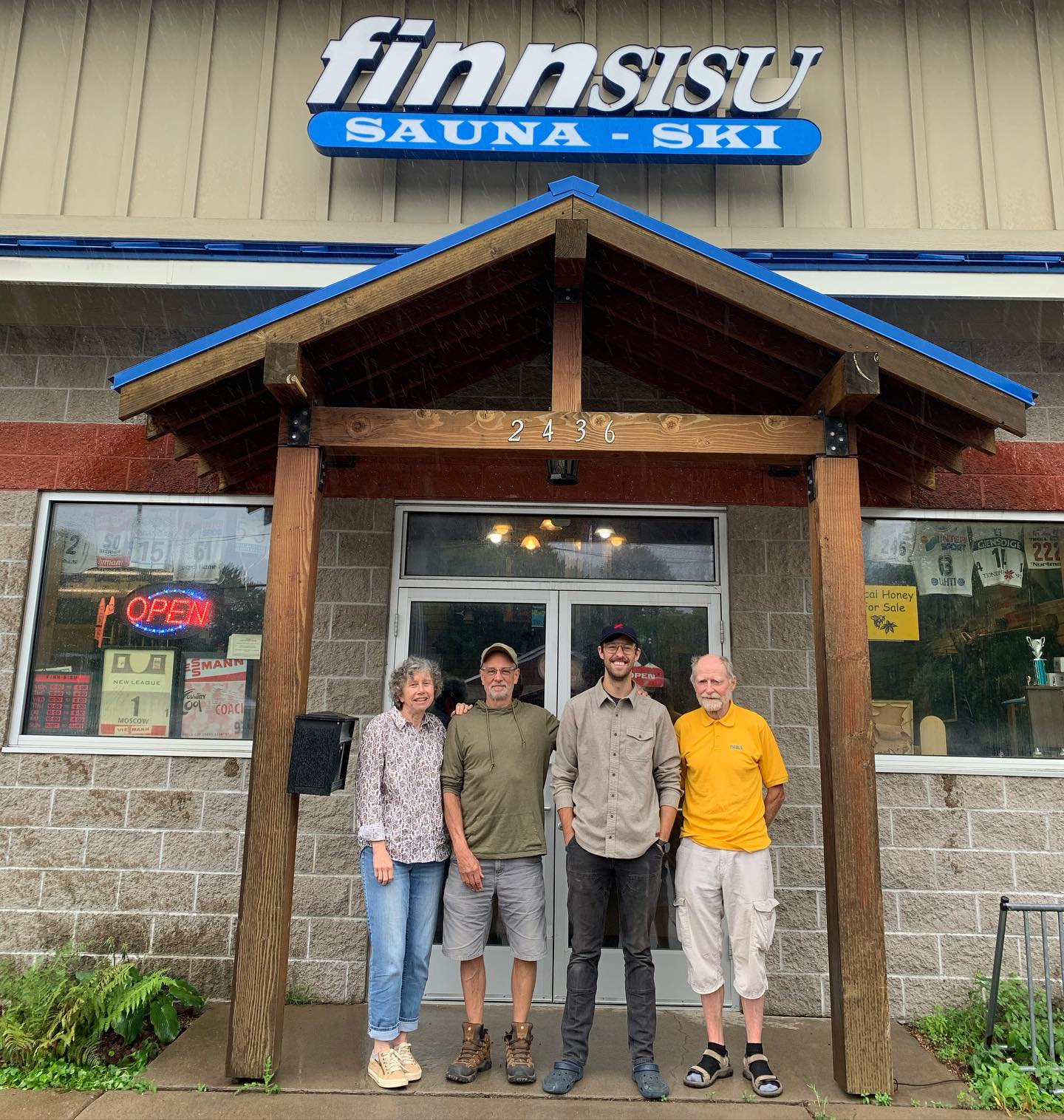
Finn Sisu may not have been the first place to sell skis in the Twin Cities, but it was the first “ski shop.”
Ahvo Taipale, a Finnish immigrant and Agricultural Engineer, had spent a decade competing (and often winning) cross-country ski races across the Midwest before he looked around at the growing number of Twin Cities skiers doing new races like the American Birkebeiner and realized that someone would need to provide all those skis. In 1978, he opened his shop, Finn Sisu. Since then, amid the vibrance and diversity of Minnesota’s largest city, there has always been the option to park in the little nook off Larpenteur Ave. (or University Ave. before 2009), walk under the blue and white cartoon Viking, open the door, and furrow completely into cross-country skiing. At Finn Sisu, you can buy skis. But you can also spend five minutes, or an hour, or a whole afternoon, living amidst all that those thin planks of wood had created. Over the course of 45 years, the place to buy skis—Finn Sisu—became the center of a ski community.
Last month, Taipale sold Finn Sisu to three long-time employees: Nate Rhode, Tom Novack, and Karen Weium. It was the biggest transaction of Taipale’s career, and couched among the terms and conditions were the intrinsic motivations that keep and grow a ski shop, and how to foster the community. In two parts, we at FasterSkier will investigate just that. First, the plans for Finn Sisu as it goes forward with a new collective ownership. Then, in Part II, the story of Ahvo Taipale, the Finnish farm boy who’s been on skis—and providing others with skis of their own—his entire life.
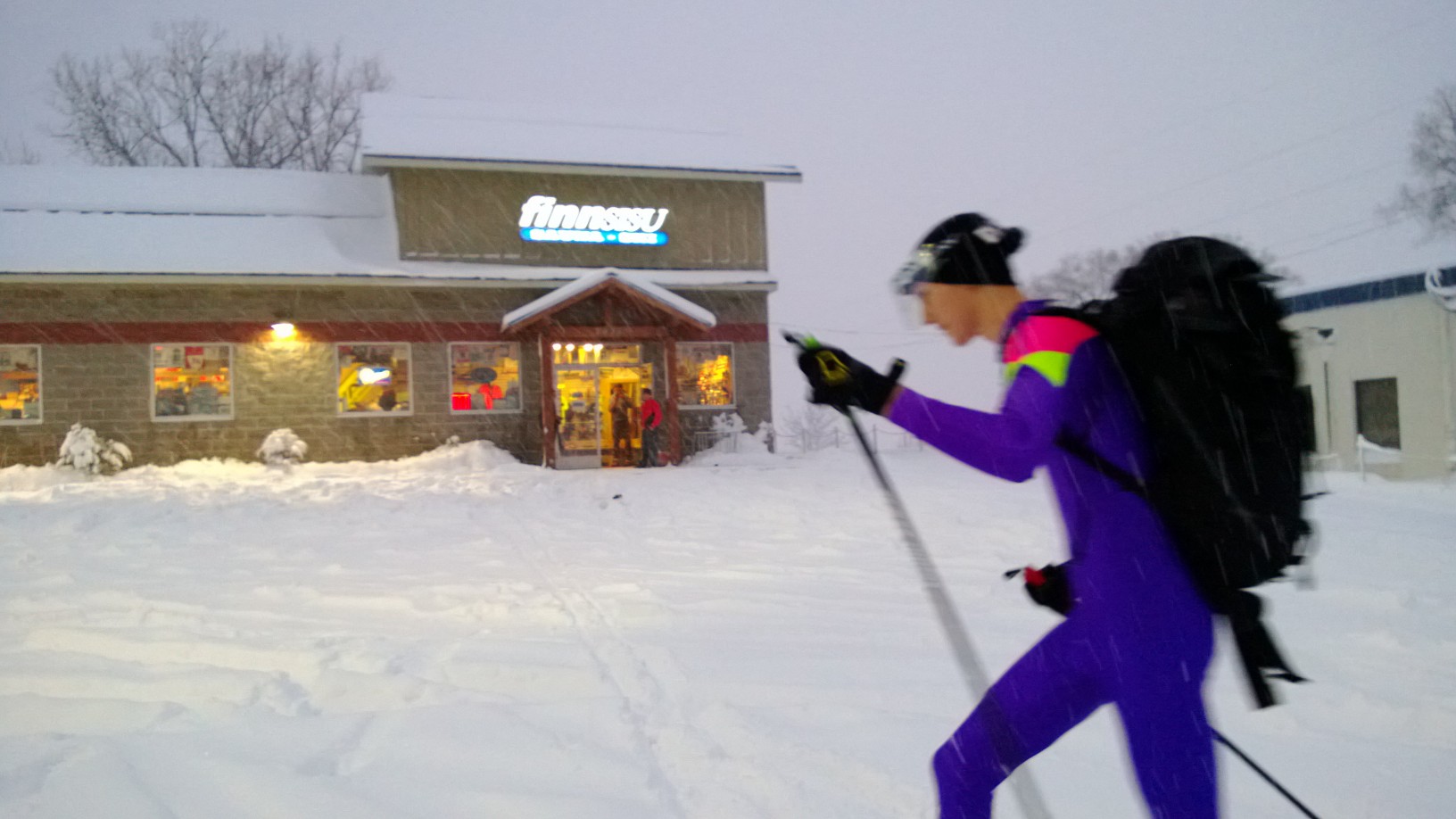
Part I: “The Keys are for Sale!”
Ahvo Taipale set the tone with the first addition made to his ski buisness at Finn Sisu. A customer walked into the new shop in the winter of 1978—named after Taipale’s homeland and its national spirit—with a different product in mind. “I was sitting there, and they came in and asked, ‘this is a Finnish shop, yes?’” said Taipale in an interview with FasterSkier. “Well, I am Finnish, yes,” he replied. “You must sell saunas?” was the customer’s next question. Taipale’s boyhood farmer instincts kicked in: “When someone presents you with a way to make money, you take it. So, I figured out how to make a sauna.” Finn Sisu Ski became Finn Sisu Ski and Sauna. That not only led to a Twin City ski community joke a la the Ole and Lena-type—“I went into Finn Sisu the other day and bought a pair of skis, and Ahvo said, ‘Would you like a sauna with that?’”—but became representative of Taipale’s core business philosophy. Over the years, he would amalgamate more than just new product-line items, adding different folks, with different talents, to his ever-growing shop.
Karen Weium was one of those. The new owner of Finn Sisu was a customer, first, at Taipale’s shop, stretching back through her time on skis, which includes a staggering streak of 35 American Birkebeiners. For Weium, the visit to Finn Sisu was a periodic one over the years as she managed a first career in publishing. “I came in about a decade ago to help Ahvo with some photos,” she said. “From there, little-by-little, started to do more.” When did it cross her mind that she might be on the path to owning the shop? Not until the deal was nearly done.
That became the case with Weium’s new co-owners, too. Tom Novak is a particular kind of gear-nut, a ski technician’s ski technician who came into the business when wood bases were being prepared with pine tar. He now owns a stone-grinding machine that’s capable of turning out grinds on carbon fiber skis with digital precision. Nate Rhode’s college job was working for Taipale before he walked a similar path to his now-predecessor. To hear Taipale tell it, “Tom went into engineering after college at the University of Minnesota, and then came back to me saying, ‘I like the atmosphere in skiing much better,’ and I replied, ‘well I did too!’”
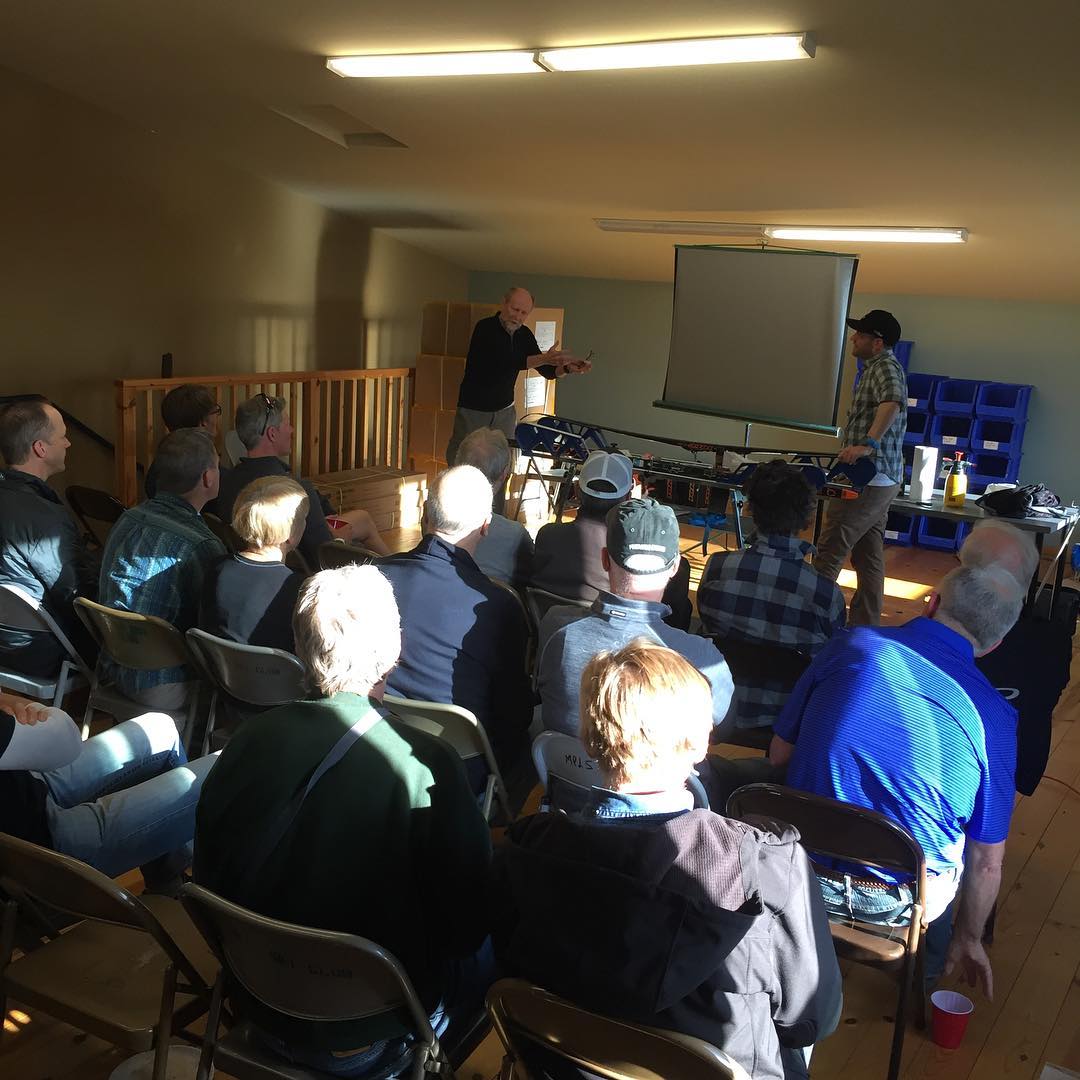
The group that now owns Finn Sisu is just the center of an expansive network that includes customers, lesson-goers, Valkava racers, sauna owners, and Birkie skiers (lots of Birkie skiers). In each case, the customer experience was what they got up front, and what formed their most important impression of the Finn Sisu they wanted to be part of, “Ahvo was generous up front, honest, and just came you an immediate sense of his knowledge and passion for the sport,” said Weium. “It made me want to be more a part of it, and I am very lucky that I did that.”
That was the way of doing business over the years, as Taipale adapted and expanded his practice with the sport he was working to grow in the United States. When the racers started coming, he expanded the types of skis he could sell. When more people looked to get into the sport, he expanded to offering entry-level skis. Rollerskis came, new wax formulas, fiberglass and then carbon fiber skis, NNN bindings, and stone grinds. But with every customer, the philosophy was the same: “Be honest, be truthful, and get them what they need” said Taipale. If that meant fitting and re-fitting skis for hours, he would do it. If that meant occasionally admitting that he didn’t have the best fit, he would send them where they could find it. “The customer won’t remember exactly what they bought,” he said. “But they will remember their experience that went into finding it.” Taipale also was attendant to the race community that his shop had found an impetus in serving, “When I started out, I needed to be at races, because I knew that was where my customers are. I still do that, but there’s a lot more happening now. High school races and junior national qualifiers, and college racing, and I am not anywhere close to being in school anymore!” To serve those racing communities, Taipale sourced expertise elsewhereL: “I always like employing young people who are passionate about the sport,” he said. “Because they know how it is changing and how I need to change my approach to giving customers good service.”
Much of that dissemination of critical ski business information happened in the same types of settings that customers at Finn Sisu came to expect. “It [was and is] the kind of shop people like to hang around and listen to how we are working with our customers.” In the shop’s main ski fitting area, you can find one employee talking details about ski fit as another holds forth on the kinds of debates skiers like to have, ranging from technical to down right existential: “How about that wax in that temperature?” “Classic or skate?” “How cold is too cold?” Over his half century in the shop, hearing Ahvo hold forth on any and all topics was as big a draw as the shop inventory.
What Finn Sisu has become is likely to continue. “Ahvo will still be around to be Ahvo, I’m sure,” said Weium. “But what we have from the way he conducted business is a blueprint for creating a shop that people want to be part of.”
What will that look like? “We’re hoping that it’s not too noticeable,” Weium admitted. “If people have valued our way of doing business, then our main job is to conduct ourselves with those values.” That core focus sets Finn Sisu up to change as the sport changes: “We recognize that things change and change very quickly in the ski business,” said Weium. “A couple of years ago, for example, we pretty much went from having fluorocarbon topcoats in the front display cases, and now they’d sit on the shelf all winter if we had them out. There’s also a lot changes to how we sell skis. The young racers we work with used to all come in to get fleets of skis on their own, and now, we’re doing a whole lot more team fleet orders, which points to a different attitude towards accessing this sport at that level. These types of things are things that we as a shop don’t control, but are essential for us to adapt to quickly.”
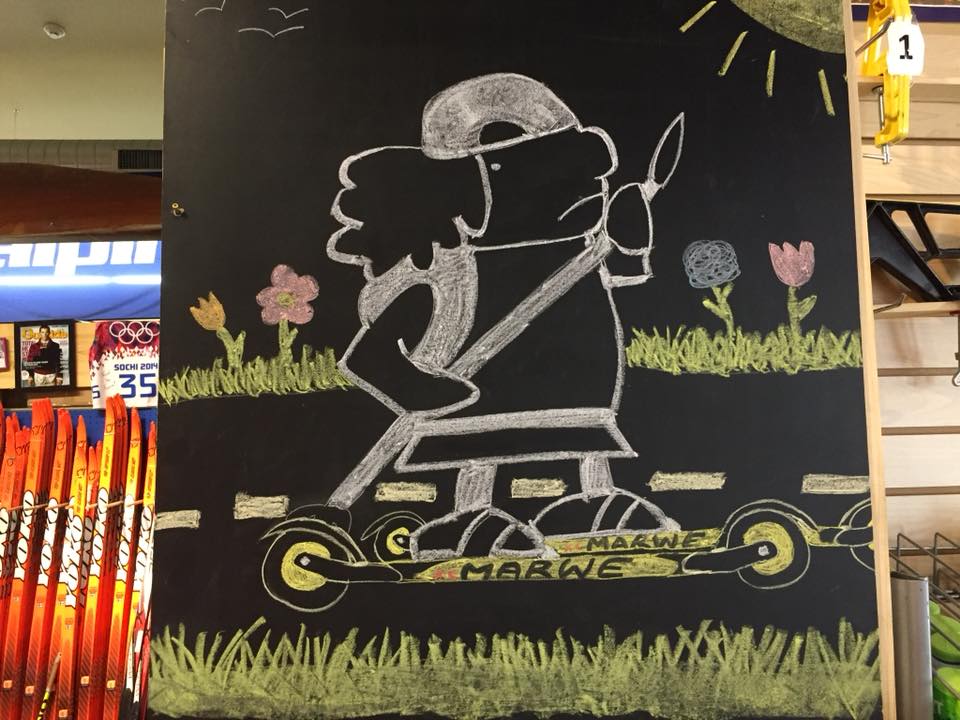
That same adaptability is something that the new owners at Finn Sisu are maintaining when it comes to the parts of the business that extend to community-building and service. “There’s things like the training group we have at one point that was the largest training group in the Twin Cities,” said Weium. “And now, we’re super small compared to the Loppet Foundation, Minneapolis Ski Club, and Endurance United.” In weathering the sometimes-rocky trail that comes when little cultural shifts change the sport the shop is centered around, there’s a kind of paradox that Weium points to for success: “As a business, we’re very focused on doing our best in every interaction with customers,” she said. “But with sponsoring races or programs or events, we have gained a lot of experience knowing that not everything has to be a success. There will be starts and stops, but the important thing is for us to continue to support the ski community, that’s something Ahvo really cared about.”
Both the old and new owners of Finn Sisu agree that what all the philosophy and community-involvement lead to is a simple pleasure with profound implications. “With us having been here for fifty years, we’re one of the few shops that is lucky enough to have served multiple generations of skiers,” said Weium. “It’s always a cool moment when a parent comes in and says, ‘I bought my skis here when I was in high school and now my kids are getting into the sport.’”
“I got to see skiers grow up and bring new skiers into the sport with their families,” said Taipale. “How lucky am I to have done that?”
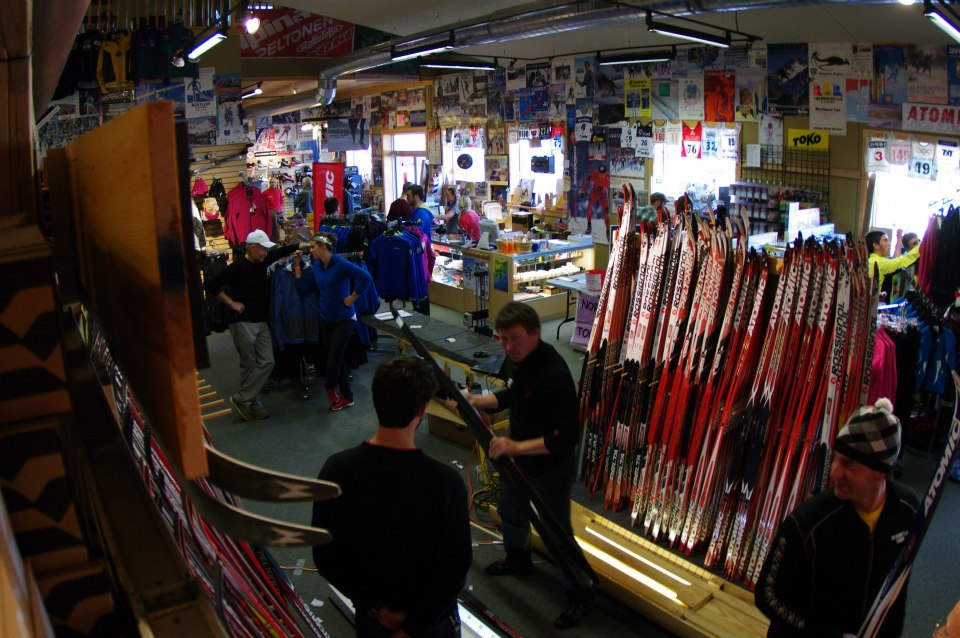
Continuity, in customers, and in community, is ultimately what proved to be the defining quality of Taipale, and the ski shop that he started forty-five years ago. “[When I started to think about retirement] a couple of years ago, I got an evaluation and went to the business brokers saying that they could put it on the market. I pretty quickly thought about all the skiers that we serve, and kind of panicked that there might be an operator who would shut down the ski side of the business and keep the sauna side open. Pretty quickly after that, the staff got used to me saying ‘keys are here, and they’re for sale!’”It ultimately took a few years, but spearheaded by Nate Rhode, the right combination of Finn Sisu staff and community members were ultimately coming together with a simple mission: keep it going. The deal they reached allowed Taipale to step away into retirement, and for the new collective to immediately take the shop over, rather than financing things in a way that would have essentially changed the business. “I wanted to get it done, but not change it too much,” said Taipale.” So something like giving them the option to buy the building later and lease it [for cheap] so that they would still be in the same neighborhood, especially when we are the only shop on that side of the [Twin] Cities, was very important.”
As the ski season begins to appear on the horizon, business at Finn Sisu doesn’t look all that different. And that, said Weium, is the sign that things are going well. “There’s definitely some anticipation of how the winter will go,” she said. “But I think if anything, we’re all more thankful to be part of it.” Taipale, meanwhile, is into retirement, having headed back to the country that gifted him his love of skiing, saunas, and of course, sisu. His parting words were a vote of confidence: “I wanted there to be continuity [at Finn Sisu]. And there is now. Customers who have come to Finn Sisu for 50 years can walk in, and it’s still Finn Sisu. I feel very lucky about that.” And the keys to the Twin Cities oldest ski shop? They’re in the hands of Karen Weium, Tom Novak, and Nate Rhode’s. Finn Sisu is not for sale, anymore.
Ben Theyerl
Ben Theyerl was born into a family now three-generations into nordic ski racing in the US. He grew up skiing for Chippewa Valley Nordic in his native Eau Claire, Wisconsin, before spending four years racing for Colby College in Maine. He currently mixes writing and skiing while based out of Crested Butte, CO, where he coaches the best group of high schoolers one could hope to find.



